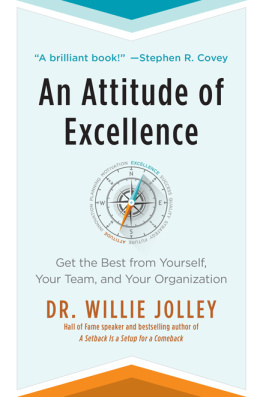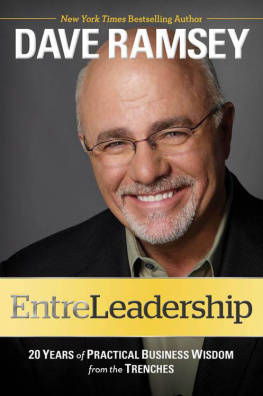Introduction
Think back to every single business book youve ever read in an effort to become a better leader. Count them up.
Im talking about everything the big to the small. From Good to Great and The Five Temptations of a CEO to the lesser-known titles you often see recommended in your mastermind groups and business networks.
Id be willing to bet that the final count of books youve read is in the dozens. Perhaps it even breaks into 3 figures. Youve read them all . As any good business leader does, youve committed yourself to learning, to the constant pursuit of knowledge that you can use to strengthen your companyand your own professional game as a CEO or member of a leadership team.
Youve put in the work.
So why does your business still feel like a struggle?
Its not a problem with the books, thats for sure. The books you read are fantastic. Each time you learn a new concept, system, or framework, youre fired up and ready to go implement it in your organization. You even give the book to your fellow business leaders so that they can align to the new thing youre all going to put into action to scale, grow, and reach success faster.
You have all the information you could ever need. So why does it feel like it never truly gets a foothold in your business? Why is making all these incredible ideas a reality so hard ?
The answer does not lie in the what but in the how. As a CEO or leader of your first startup early-stage, or a seasoned 20-year Fortune 500 CEO, you have learned what to do but have little step-by-step guidance on the how to implement the what with your team.
Nothing ever seems to connect.
You have a team and a plan. But they do not connect.
The same is true of thought leadership. Youve read every great book the business world has to offer, and the ideas are great but separated. Theyre not connected.
How do you pull them all together into one connected system that will work for you, your team, and your business? How do you unify every tried-and-true business framework, glue them together, and create and align a repeatable, structured, strategic execution process for your whole business?
The answer is this book. The answer is Metronomics.
I Was a Desperate CEO
Even though youre experiencing these struggles, you probably dont think of yourself as desperate . I know I didnt. It was only after I developed Metronomics to pull myself out of burnout and overwork, and saw how much freedom I could truly have in my life as a CEO, that I realized how desperate things had been. I coined the term Desperate CEO to describe the place business leaders find themselves when theyve read every book, tried every method, and still cant get any momentum going in their business.
When I started my first company, Paradata, things didnt start in the Desperate CEO zone. My co-founders and I were in our late twenties. We had tons of energy, optimism, and drive. We had discovered a problem in the world for which we had a unique solution, and we were venture-funded from day two of starting up our business. We had a great global growth opportunity. I was a super-young CEO, and I had gone from begging for money to the phone ringing off the hook for customers who wanted to buy from us.
But while we had all that energy and excitement in spades and were thrilled with our chance for growth, we had no idea how to grow the business up. We started putting in extremely long hours, grinding it out, working harder, like it was a badge of honor. Cool! With all that extra effort, all the time away from our families and friends, the endless hours spent working and not living the play-hard life we had all envisioned, we were killing ourselves.
And as a result, the only real grind was our growth as it damn near came to a halt.
Like youve probably done from the moment you became a CEO or leader, I started reading obsessively. I read the books of all the most respected and renowned business thought leaders. I attended their workshops and conferences like a rock-band groupie, trying to find them wherever they were and showing up whenever possible. I read four books a week for 24 months straight at one pointtaking in a ridiculous amount of data and informationhoping to find some kind of repeatable system, a silver bullet, that we could implement to start taking full advantage of our opportunity and achieve the goals our investors expected.
And I couldnt find it. There was no one system.
It was unbelievable. With all the successful businesses in the world, no one had taken the time to write down the system they used.
As human beings, we crave repeatable, structured systems. We seek them out. You can see this in sportswhich I lived and breathed for decades, growing up as an athlete. When you play a sport, the most successful teams always have a system and a cohesive culture that determine how that team operates and behaves. You always know who is in what role, what is expected, and what part every role plays in the teams success. Every individual is committed to the common team goal.
I thought the same thing should be true of business, and I wantedneededto find that blueprint. It had to be out there, right?
Well, Ive already told you. It wasnt. Or at least I could not find it.
Instead, there were great pieces, but they were disparate, taught as siloed frameworks or tools on specific areas of a business: culture, cohesive teams, hiring, strategy, planning, execution, finance, cash. The problem was that, if they were implemented one by one, they werent working together. In my business, it felt like I was constantly saying, Look over here and fix this. Now look over there and fix that. They were one-and-done tools that only gave us one perspective at a time, not a connected, sustainable system. It was here, then there, then therelike a game of Whack-A-Mole.
That was not going to get me and my co-founders the growth we so badly needed for the company and what we committed to our investors.
I went to work with my leadership team and coach to create a system that pulled everything together. It wasnt easy, and it wasnt quick. There was a lot of guesswork, a lot of failures, and the pain of only seeing slow incremental evolution when what I wanted, as a Desperate CEO, was to wake up one morning and have my business run effortlessly.
But, over time, we started to see the results of the connected system we were building, and step by step, things got easier. We had less stress, more free time. The team understood the Core Purpose and actually had a connected system to drive measurable team results. We could see business outcomes grow up, quarter after quarter. Eventually, it was clear that we were on to something. This is the system I eventually named Metronomics.









